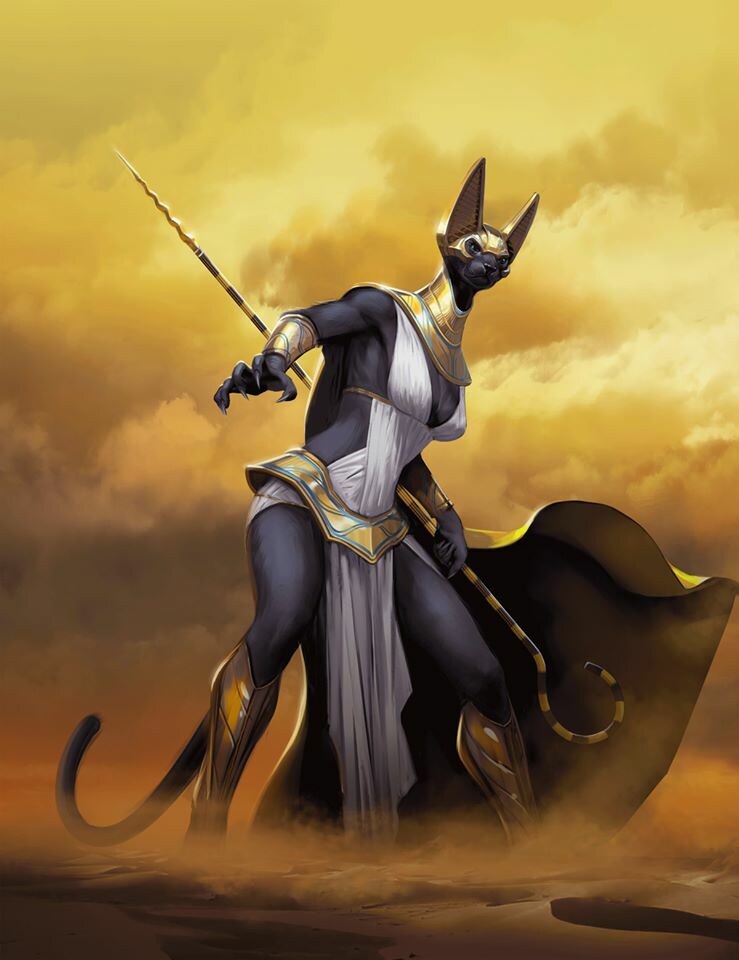Bastet

Bast (Bastet, Pasht) In Egyptian mythology, cat goddess worshipped at Bubastis in the eastern delta. She was looked upon as a manifestation of the solar eye and was even referred to as “the Eye of Ra who protects her father Ra.” Bast, who loved music and dance, was the protector of pregnant women and also protected men against disease and evil spirits. Generally, she was considered the personification of the beneficial, fertilizing power of the sun, whereas her counterpart, Sekhmet, the lion goddess, represented the fierce, destructive power of the sun.
Bast became an important national deity about 950 b.c.e., and her festival was among the most popular in Egypt. According to Herodotus’s History (book 2), vast numbers of men and women came to her festival by barge, singing and dancing, clapping their hands, and playing the castanets. On their way the women would shout abuses and even expose themselves to those along the shore. At Bubastis the feast was celebrated with abundant sacrifices and festivities. Dead cats were carefully mummified and buried. It was said that more than 700,000 devotees attended Bast’s yearly festival and that more wine was consumed than in all of the rest of the year besides.
In the Bible the Hebrew prophet Ezekiel (30:17) refers to Bast’s city, which he calls Phibeseth, and says of Bast’s worshippers that the young men will “fall by the sword” for their worship of her.
Egyptian art usually portrays Bast as a woman with the head of a cat. She holds in her right hand a sistrum for her music and in her left a shield with the head of a cat or lioness at the top.
SOURCE:
Encyclopedia of World Mythology and Legend, Third Edition – Written by Anthony S. Mercatante & James R. Dow– Copyright © 2009 by Anthony S. Mercatante

Bastet : Mistress of the Oracle; Great Conjuress of the Casket
Bastet, great cat goddess, has dominion over sex, fertility, marriage, magic, music, childbirth, prosperity, joy, dance, and healing—in short, the pleasures of life. She protects humans against infertility, dangers of childbirth, evil spirits, illness, and bodily injuries, especially those caused by venomous creatures. A tomb inscription says Bastet bestows “life, prosperity and health every day and long life and beautiful old age.”
Bastet offers special protection to women and children and serves as matron of magicians and healers. Her cult began in the Nile Delta swamps. The earliest known portrait of Bastet dates to circa 3,000 BCE. By about 950 BCE, she was worshipped throughout Egypt. For a while, she was the most popular goddess in the kingdom. Her veneration reached its zenith during the reign of Osorkon II (874–853 BCE), when a major temple was erected at her cult city, Bubastis. Devotion to Bastet officially survived until 30 BCE and the Roman conquest, the Romans having little sympathy for animal-shaped gods.
Her annual festival in Bubastis was Egypt’s most popular. A precursor of modern Mardi Gras, it was renowned for parties, revelry, and drunkenness. Herodotus, the Greek traveller and historian writing in the fifth century BCE, claimed that more wine was consumed in Egypt during this festival than during the entire rest of the year. Although many details are lost, Bastet’s festival celebrated female sexuality and generative power. Boats sailed up the Nile toward Bubastis. As each barge approached towns and settlements, it would halt and the mainly female celebrants on board would loudly hail local women congregating on the riverbanks. They would shout sexual obscenities to each other, dance wildly, and perform anasuromai, the ritual act of lifting up the skirts to expose the vulva, associated with laughter, healing, and defiance of grief.
Bastet may be the wife and/or daughter of Ra, the sun. Among the spirits described as her sons are Maahes, Khonsu, and Nefertem.
ORIGIN:
Egypt
Iconography:
She is depicted as a cat, often bejeweled, or as a woman with a cat’s head, sometimes surrounded by kittens and fashionably dressed in a green or blue dress.
ATTRIBUTES:
Basket and ankh (symbol of life)
Planets:
Sun and moon
COLOUR:
Green
ANIMAL:
Domestic cats are her servants and sacred animals.
OFFERINGS:
Her name may be related to a word meaning “perfume.” Ancient Egyptian perfume was typically in the form of a salve. Offer her precious cream perfumes or offerings that benefit her sacred animal, cats.
SEE ALSO:
SOURCE:
Encyclopedia of Spirits: The Ultimate Guide to the Magic of Fairies, Genies, Demons, Ghosts, Gods & Goddesses – Written by : Judika Illes Copyright © 2009 by Judika Illes.










